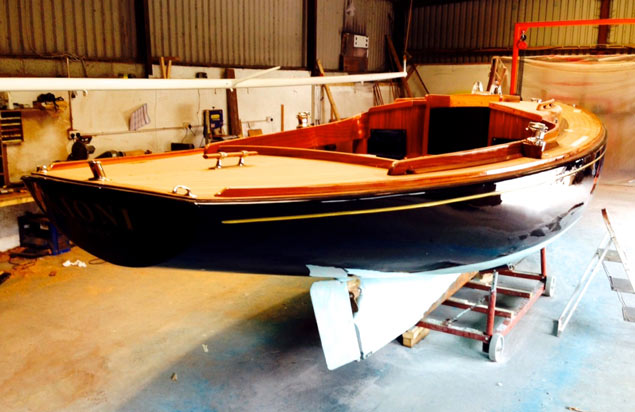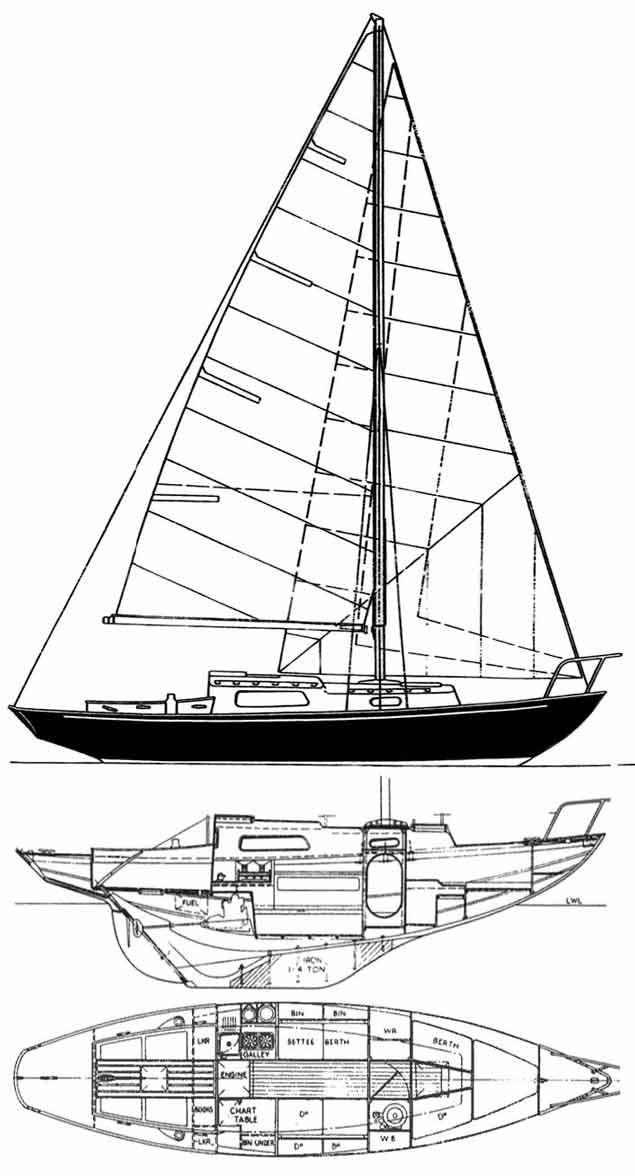Displaying items by tag: Colleen
Double Vision? Cork Harbour's Late Summer Brings Twin Versions of Classic Yachts
Those who have been rewarded for their careful adherence to social distancing and crew-pod rules by getting some sailing in the Indian summer which has been at its very best on Cork Harbour can be forgiven for wondering if, despite all their precautions, they've been afflicted by a mild bout of double vision.
For if you've been sailing down off Crosshaven, now and again you'll see this pretty little transom-sterned dark blue sloop with a nice crisp suit of new sails, out happily slicing her way with very little fuss across the blue water, her general appearance exuding quality construction, and her lone helmsman very deservedly the monarch of all he surveys.
 "Very deservedly the monarch of all he surveys". Photo: Bob Bateman
"Very deservedly the monarch of all he surveys". Photo: Bob Bateman
Yet if you're sailing further up the harbour off Monkstown on a somewhat similar day – for they seem to have had them in profusion – you'll have seen what looks to the casual observer to be the same boat, yet how does she seem to have two totally different home berths?
The up-harbour boat we featured here on August 14th, and she is, of course, Pat Murphy's Kinsale-built (in 1952) Colleen 23 class Pinkeen, beautifully brought up to condition by a combined effort by Pat and Jim Walsh of Walsh Boat Works in Nohoval.
 Happy man – Pat Murphy at the helm of Pinkeen off Cobh. Photo: Bob Bateman
Happy man – Pat Murphy at the helm of Pinkeen off Cobh. Photo: Bob Bateman
But the other boat – whose differences any dedicated aficionado can spot immediately – is a sort of nautical trompe l'oeil, as she's a complete re-working of a well-used but still sound fibreglass hull through the special genius of Bill Trafford of Alchemy Marine in Doneraile in North Cork order to create something else altogether.
Like many, Crosshaven sailor Philip Brownlow has the fondest memories of the three Alan Buchanan-designed Colleens which used to be based in Kinsale, where they'd been inaugurated by Nolly Stokes and John Thuillier. But while he wanted the spirit of the Colleens, he didn't want the demands of the continuous maintenance of an all-wooden boat, so he set Bill the challenge of re-purposing some other class's fibreglass hull to capture the Colleen essence, and Bill reckoned he could make the hull of a Kim Holman-designed Elizabethan 29 do the job, and this was how it was done. Nobody involved in the project makes claims that this is a Colleen 23. But they rightly believe that she captures the bright spirit of the Colleen 23, so maybe we should simply call her the Colleen 27.
 In distant Doneraile, the Colleen spirit is created with a re-purposed Elizabethan 29. Photo: Bill Trafford
In distant Doneraile, the Colleen spirit is created with a re-purposed Elizabethan 29. Photo: Bill Trafford
If you see Pat Murphy's Pinkeen and Philip Brownlow's Sunflower side-by-side, it's easy to spot the differences – not least because of the size gap – yet equally, the shared spirit shines through.
But if you happen to see them at two different times in different places in the harbour on the same day, confusion is understandable. As one occasional sailor put it: "The only way I know which is which is because one helmsman wears a Jack Charlton cap, and the other doesn't."
Alchemy Marine Will Work Magic to Re–Create Cork Harbour Classic Boat of 65 Years Ago
Bill Trafford of Alchemy Marine, hidden away in the farmland of Skenakilla west of Mitchellstown in north County Cork, has carved himself a unique reputation in recent years for successfully re-imagining glassfibre boats of a certain age, and transforming them into modern classics writes W M Nixon.
In fact, calling them “boats” at a key stage of this process is scarcely accurate. What arrives in his shed as a former but still recognisably standard sailing craft quickly becomes no more than “the donor boat”, which is soon a bare hull with which Bill is free to play, re-tweaking the sheerline, altering the stern, and adding a completely new deck and coachroof configuration
That’s just for starters. But with the former Elizabethan 23 Kioni, and more recently the former Etchells 22 Guapa, the process is indeed magic, because both boats have ultimately emerged as beautiful head-turners wherever they sail.
 The beautiful Kioni was created from a lengthened Elizabethan 23 glassfibre hull. But now Bill Trafford plans to re-create the spirit of the Colleen by shortening an Elizabethan 29 hull
The beautiful Kioni was created from a lengthened Elizabethan 23 glassfibre hull. But now Bill Trafford plans to re-create the spirit of the Colleen by shortening an Elizabethan 29 hull
But while he was given a lot of freedom in making choices with those boats, Bill’s main project this winter is for a very specific project.
Back in 1950, some members of the Royal Cork YC commissioned a boat from up-and-coming yacht designer Alan Buchanan. They wanted a miniature yet classically stylish performance cruiser, just 23ft 2ins LOA, to be called the Colleen and capable of being built locally.
The 1950s were very far from being a boom time in Ireland, so it seems that no more than four were built. But one or two are still about, and a contemporary Cork Harbour sailor fancies the look of them, but doesn’t fancy the hassle of maintaining a wooden hull.
So now Bill Trafford faces the challenge of creating a new Colleen from a glassfibre hull donated by some other boat. He quickly realised that the Buchanan-designed glassfibre Halcyon 27 – which has a transom stern – was otherwise unsuitable, so he settled on the Elizabethan 29, designed by Kim Holman and built with great success by Peter Webster in Lymington in the 1950s.
 The original Colleen profile. While the spirit of the boat will be re-captured, it’s possible the very vigorous sheerling will be slightly softened by moving the lowest point a little bit further aft
The original Colleen profile. While the spirit of the boat will be re-captured, it’s possible the very vigorous sheerling will be slightly softened by moving the lowest point a little bit further aft The Elizabethan 29 in unaltered form – it takes Bill Trafford’s vision to see a Colleen in there somewhere
The Elizabethan 29 in unaltered form – it takes Bill Trafford’s vision to see a Colleen in there somewhere
He found one in giveaway terms on ebay in the middle of England at Milton Keynes, and Jonathan Kennedy of Kennedy Boat Haulage personally undertook the long trek to move the little boat from a neglected condition in the middle of England to a winter of transformation in the middle of Munster.
Having seen what Bill Trafford has been able to do with a former Elizabethan 23 and a former Etchells 22, there’s no need to doubt that the spirit of the Colleen will be re-captured in that secret laboratory near Skenakilla Cross-roads. And those of us who feel that the vigorous sheerline of the original might have been better if it had the lowest point slightly further aft may even be indulged in our views. But that of course is up to the owner, who has greatly brightened the prospects of the winter by commissioning this fascinating project
 The donor hull of the Elizabethan 29 arrived in the yard, awaiting a miraculous transformation. Photo: Bill Trafford
The donor hull of the Elizabethan 29 arrived in the yard, awaiting a miraculous transformation. Photo: Bill Trafford






























































